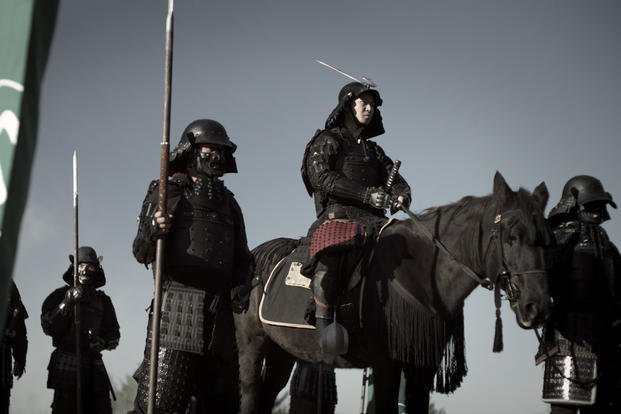“Age of Samurai: Battle for Japan” (now streaming on Netflix) digs deep into the military history of Japan, detailing the 16th- and early 17th-century battles that introduced new sophistication to combat tactics and eventually brought the country under one united rule.
The six-part series features the now-standard combination of historical reenactment scenes intercut with a group of historians detailing the history we’re seeing on screen. “Age of Samurai” sets itself apart by casting talented actors in the most important roles, adding in outstanding production values and fight choreography.
The action could pass for scenes from a big-budget war movie, and there’s a more than realistic depiction of the bloody sword violence that dominated warfare during the era. There’s plenty of slow-motion slicing and arcing blood, but the depiction seems designed to drive home the up close and personal nature of the warfare instead of just satisfying an audience’s love of gore.
Over the course of six hours, the filmmakers spend a lot of time on the specific tactics behind each battle they depict, letting the experts detail advance planning, how the commanders pivoted during battle and how new weapons and tactics transformed the nature of war during the era.
The series focuses on three warriors, men whose leadership tamed centuries of fractured chaos in Japan. Oda Nobunaga, Toyotomi Hideyoshi and Tokugawa Ieyasu are names as well-known to Japanese students as George Washington, Ulysses S. Grant and George S. Patton are to Americans, but most of this history will be new to Western viewers.
What most of us know about samurai comes from movies and comic books, but the actual nuts-and-bolts history behind the legends is far more interesting than any fictional version might suggest.
Matt Booi was the showrunner for “Age of Samurai: Battle for Japan,” and he took time to speak with us about the making of the series.
Military.com: A lot of low-budget history shows have featured talking heads intercut with a few actors looking uncomfortable in period costumes as they pretend to reenact big moments from the past. Your documentary turns that tired formula on its head with great acting and compelling action scenes that look like they’re from a movie. How did you pull that off?

Matt Booi: For us, everything comes from the story. We tried to find compelling characters who have incredible obstacles to overcome. We realized that if we didn't have real Japanese actors, ones who could speak perfect Japanese, we were going to die on the authenticity front. If that didn’t happen, the people who we wanted to watch were going to tune out instantly. I always try to stress that we're not interested in chronology. We're interested in telling the story. And that's kind of our mantra.

Military.com: As I watched, I thought that you could strip out all the historians and that the series could almost stand by itself as a feature. The fight choreography is especially impressive.
MB: There was a big commitment from every department to try and make it as authentic as we could. We were really lucky to have a great director in Stephen Scott, who really worked hard to try and give the battles some bites and some grit.
We had a boot camp for the actors and stunt people, spending days and days to get them ready for what we were going to do and get them used to the weapons. We also tried to pick people who obviously had a facility with these skills.
Everyone involved knew this was something special and tried to bring their A game. We knew this was for a global audience. When you work for Netflix, your show can be turned on at any time of day from anywhere in the world. We’re competing with so much content that we were really aware that we had to try and do our best on every level.
What I found so incredible about this project was that the deeper we dug into it, the more fascinating and incredible and interesting it was. I taught high school history for years, but this story was a blind spot for me. The more we all dug into it, the more fascinating and incredible it became. There are just so many moments where you have trouble believing that this story is true.
For example, there’s the Battle of Sekigahara. I won’t give away details for people who haven’t seen it yet, but [Kobayakawa] Hideaki’s decision during the battle is something straight from a movie. The fact that it actually happened, and that the battle happens at the end of the series like that, is fascinating.

Military.com: The history of World War I is very much about a shift warfare technology and how some people adapted and others didn't. With the introduction of the arquebus long gun into the mix during the 1500s, the emerging weapons seem to play a major role in how this era plays out.
MB: In some ways, it really is a story about how technology changes the landscape. But we kept trying to deal with this on the personal level, in terms of how these individuals are reacting to what's changing on the ground and the decisions that they make. That’s how we tried to make it compelling for people who maybe don't know the history. We wanted the series to function as a story.
This is a really compelling story, especially Episode One. I think about Nobunaga and the tough situation in which he finds himself. He is, as one of the contributors says, a small fish in a pond full of whales. How is he going to get ahead? Nobunaga does that through a brilliant combination of embracing new technology and also rejecting the rules of warfare that had bound so many people before him.

Military.com: The show ends with a relative domestic peace for Japan that would last for more than 200 years. Is there a way for you to continue this story with another series?
MB: Obviously, we're still exploring what's going to happen next, but we just scratched the surface with “Age of Samurai: Battle for Japan.” This story really focuses on unification and the end of the Warring States period. But as you know, the history of the samurai really predates the period that we're talking about here. There are opportunities to tell some really fascinating stories about the origins. We're kicking around some ideas right now; I don't want to tell our competitors what we're doing.

Military.com: There’s an intense focus on military strategy in your series. There’s a tendency in even the best war documentaries to cover the buildup to a battle and then gloss over the actual uncertainties in the battle itself, treating the outcome like a foregone conclusion. Why did you focus so much on the internal drama of each battle?
MB: When it came to strategy, we thought it was so imperative and important to lay out what these main characters were facing. We were trying to tell a personal story and to understand the obstacles that are placed in each of these men’s way. We wanted the viewers to understand how the odds were so stacked against them.
Those are great devices to engage an audience. You know that Nobunaga is outmanned, in some cases 10 to one, and he's going to go against them anyway. But he's going to try and not engage the main body of troops, but instead simply decapitate the leadership. That's a compelling story.
If we act like everyone knows the outcome and let the cat out of the bag, what's gonna happen? The majority of people who will watch this series are unfamiliar with Japanese history, so they're not going to really know who's going to win this battle. I think it's so much more fun and engaging to almost pretend that you're a soldier on the ground, and you only know that you've breached.
How will this battle unravel? Is it going to go one way or the other way? Viewers don't know until the smoke clears. That's the great thing about these stories. Most Westerners don't know the outcome.
For Japanese viewers, these battles are their Gettysburg or their Antietam. They know this stuff, but we don't. Because most of us don’t know this history, I think our approach is what makes it so entertaining and why it's resonating with people.
Keep Up With the Best in Military Entertainment
Whether you're looking for news and entertainment, thinking of joining the military or keeping up with military life and benefits, Military.com has you covered. Subscribe to the Military.com newsletter to have military news, updates and resources delivered straight to your inbox.

















